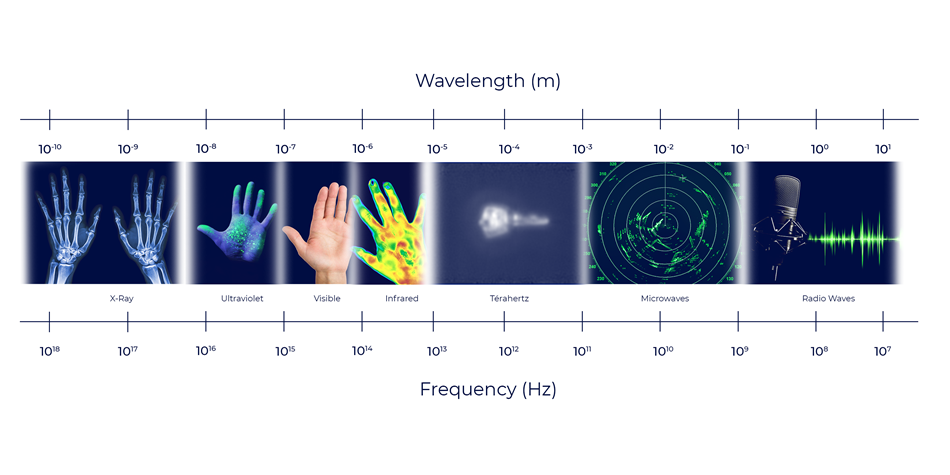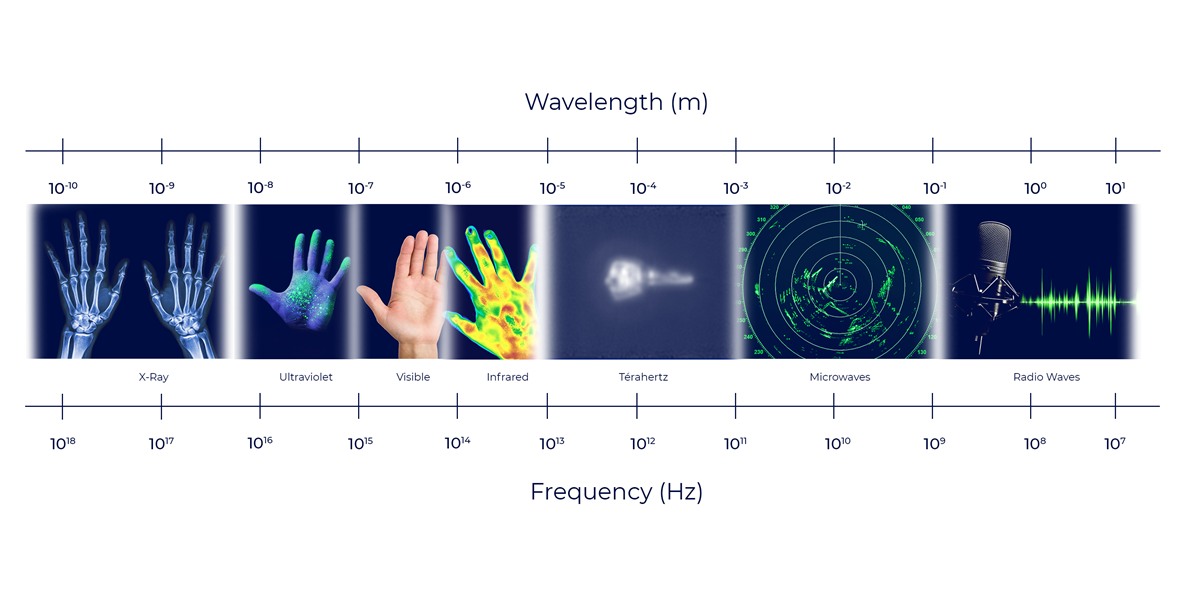Superman has an extraordinary power: his X-ray vision can penetrate obstacles that are completely opaque in visible light, which is very practical for seeing his enemies through walls. However, X-rays are not the only waves that enable us to see through matter. Terahertz waves also have this ability. They enable us to see things that X-rays do not. Superman would most certainly like to have this power.
In the following article, we’re going to explain the differences between terahertz and X-ray technologies, and the limitations of each.
Terahertz and X-rays: what the are differences?
Frequency bands
Terahertz and X-rays are two technologies that operate in different frequency ranges of the electromagnetic spectrum. The frequency of terahertz, whose wavelength is longer than that of X-rays, ranges from 0.3 THz to 10 THz, or from 30 μm to 1 mm (1000 μm) in wavelength, although these threshold values vary slightly from one reference to the next.
The frequency of X-rays ranges from 1016 Hz to 1020 Hz, i.e. more than 10,000 THz.

Discriminating power
Several materials and substances of interest have a unique spectral signature in the THz field, such as characteristic absorption rays or a variation in specific transparency depending on the wavelength. Analysis of these spectral signatures makes the identification of numerous solid, liquid or gaseous components possible, along with characterization of their composition and structure.
This great THz chemical selectivity power has been demonstrated for different types of large organic molecules: explosives, narcotics, active ingredients in drugs, proteins, food, etc.
Resolution
Waves in the THz region enable us to distinguish fine details in the environments probed. Although their resolution power is not as good as those obtained on the visible and infrared spectrum, it is far better than that of microwaves whose wavelengths are even longer. Moreover, as THz waves are longer than those on the visible or infrared spectrum, the phenomenon of light diffusion which affects the contrast and sharpness of the images is reduced.
A spatial resolution in the order of millimetres (or less) in THz is generally obtained, which is satisfactory for many applications.
Penetration power
THz waves easily penetrate many non-conductive materials that do not contain water, such as dielectrics or intrinsic semi-conductors, because the energy of the THz photons is very weak, only a few millielectronvolts (meV). Thanks to this great penetrative power, almost all non-metallic materials are transparent in the THz region: concrete, brick, wood, card, paper, foam, fabric, plastic, etc.
THz radiation is, however, capable of penetrating metal and water. Whereas metal is very reflective to these wavelengths, water brings about strong absorption of THz waves.
X-rays, however, travel in water and aqueous environments. This is, therefore, the technology used in the medical and dental field to see through the human body, whose water content is very high. However, frequent or prolonged exposure to X-rays may be harmful to health.
Radiation safety
The great advantage of THz waves is that they are not harmful to the individuals who are exposed to them. As with infrared, but contrary to X-rays, THz radiation is not ionizing: their photons do not have sufficient energy to dislodge electrons in atoms forming the molecules of a living organism, which could trigger a harmful reaction. As such, a system operating in THz does not require specific insulation or additional protective equipment to avoid exposure to radiation. Terahertz waves do not heat up. They are not destructive or harmful like X-rays. In order to operate terahertz waves, it is not necessary to protect the operators and objects exposed, or the individuals irradiated, from the harmfulness of the rays.
Conclusion
Although, like X-rays, terahertz rays enable us to see through matter, the resolution of the images produced by THz is inferior to that generated by X-rays. However, the non-ionizing and non-invasive properties of THz waves give them a real advantage over X-rays, whose emissions are harmful to health over long or repeated exposure, and alter the use of the materials that they image.
The intrinsic characteristics of these two technologies lead us to use them for different applications as the technologies cannot replace each other. Complementary to each other, they enable the imaging spectrum in the invisible field to be enlarged. To learn more about using terahertz technology for the non-destructive inspection of plastic parts, watch the webinar How to immediately detect hidden defects during the production of plastic parts.




